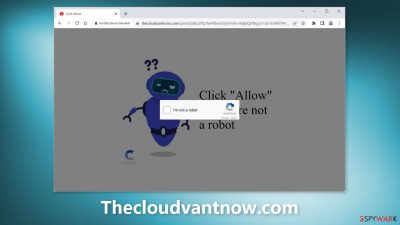Thecloudvantnow.com ads (spam) - Free Guide
Thecloudvantnow.com ads Removal Guide
What is Thecloudvantnow.com ads?
Thecloudvantnow.com misleads users by using social engineering techniques

Thecloudvantnow.com is a bogus website set up by fraudsters to trick users into subscribing to push notifications. The page masquerades as a verification step. Supposedly, users need to click the “Allow” button to confirm that they are not robots, and they will be able to proceed.
However, by clicking “Allow” users give permission to show them push notifications. They begin to receive annoying pop-up ads, which can appear even when the browser is closed. Crooks may also use rogue advertising networks to place advertisements that lead to dangerous websites.
As a result, people may end up on scam pages that attempt to obtain personal information from them or trick them into downloading PUPs (potentially unwanted programs)[1] or malware. We strongly advise users not to click on any links embedded in advertisements, even if they appear to promote legitimate products.
People typically report seeing ads promoting adult websites, bogus antivirus offers, software deals, giveaways, and surveys. That is why it is critical to turn off the ads as soon as possible, especially if other people are using the affected machine.
| NAME | Thecloudvantnow.com |
| TYPE | Push notification spam; adware |
| SYMPTOMS | Pop-up ads start appearing in the corner of the screen after the “Allow” button is pressed |
| DISTRIBUTION | Shady websites, deceptive ads, redirects, freeware installations |
| DANGERS | Links embedded in the push notifications can lead to dangerous websites where users can be tricked into providing their personal information and suffer from monetary losses |
| ELIMINATION | Users can block push notifications via browser settings |
| FURTHER STEPS | It is recommended to use a repair tool like FortectIntego after the removal to fix any remaining damage |
Distribution methods
Pages created solely for the purpose of spamming users with pop-ups have no other content. They are rarely found in search results. They are usually hidden on other shady, unregulated sites. Illegal streaming sites, for example, are full of deceptive ads and sneaky redirects.
Even though Google promised to remove fake “Download” and “Play” buttons,[2] they remain. If users come across these buttons and click on them, they may believe that if they press “Allow,” they will be able to watch the movie or TV show they chose.
It is best to only visit pages that you are familiar with and trust. Use legal streaming services such as Netflix or Hulu. They have a low monthly subscription fee and allow users to watch as much content as they want. Some may argue that it is costly, but keeping your system in good working order may save you money in the long run.

Block notifications from Thecloudvantnow.com
Because push notifications are subscription-based, they can be turned on and off only manually. We have a detailed guide for the most popular browsers below:
Google Chrome (desktop):
- Open Google Chrome browser and go to Menu > Settings.
- Scroll down and click on Advanced.
- Locate the Privacy and security section and pick Site Settings > Notifications.
![Stop notifications on Chrome PC 1 Stop notifications on Chrome PC 1]()
- Look at the Allow section and look for a suspicious URL.
- Click the three vertical dots next to it and pick Block. This should remove unwanted notifications from Google Chrome.
![Stop notifications on Chrome PC 2 Stop notifications on Chrome PC 2]()
Google Chrome (Android):
- Open Google Chrome and tap on Settings (three vertical dots).
- Select Notifications.
- Scroll down to Sites section.
- Locate the unwanted URL and toggle the button to the left (Off setting).
![Stop notifications on Chrome Android Stop notifications on Chrome Android]()
Mozilla Firefox:
- Open Mozilla Firefox and go to Menu > Options.
- Click on Privacy & Security section.
- Under Permissions, you should be able to see Notifications. Click Settings button next to it.
![Stop notifications on Mozilla Firefox 1 Stop notifications on Mozilla Firefox 1]()
- In the Settings – Notification Permissions window, click on the drop-down menu by the URL in question.
- Select Block and then click on Save Changes. This should remove unwanted notifications from Mozilla Firefox.
![Stop notifications on Mozilla Firefox 2 Stop notifications on Mozilla Firefox 2]()
Safari:
- Click on Safari > Preferences…
- Go to Websites tab and, under General, select Notifications.
- Select the web address in question, click the drop-down menu and select Deny.
![Stop notifications on Safari Stop notifications on Safari]()
MS Edge:
- Open Microsoft Edge, and click the Settings and more button (three horizontal dots) at the top-right of the window.
- Select Settings and then go to Advanced.
- Under Website permissions, pick Manage permissions and select the URL in question.
- Toggle the switch to the left to turn notifications off on Microsoft Edge.
![Stop notifications on Edge 2 Stop notifications on Edge 2]()
MS Edge (Chromium):
- Open Microsoft Edge, and go to Settings.
- Select Site permissions.
- Go to Notifications on the right.
- Under Allow, you will find the unwanted entry.
- Click on More actions and select Block.
![Stop notifications on Edge Chromium Stop notifications on Edge Chromium]()
Clear your browsers from trackers
It is strongly advised to clear your browsers after visiting such a website. Websites and web-based applications can collect data such as your IP address, geolocation, websites you visit, links you click on, and items you buy online using various tracking technologies. All of this is accomplished through the use of cookies and cache.
These small data files aren't necessarily bad. Legitimate websites employ them to personalize the user experience by displaying relevant results, for instance. They can, however, be used to generate revenue by selling them to ad networks and other third parties. This problem has an automatic solution – FortectIntego. With the click of a button, this powerful software can stop tracking and delete existing data, as well as repair serious system errors.
Check your PC for adware
PUPs can also cause unwanted browser behavior. Pages like Thecloudvantnow.com can appear without any user input at all. Adware,[3] which is a program that generates commercial content in the machine without the users' knowledge, can cause this. Many of them are disguised as “useful” tools, making them more difficult to detect for average users.
That is why professional security tools such as SpyHunter 5Combo Cleaner and Malwarebytes are essential. Anti-malware software can scan the machine for suspicious processes that are running in the background. Furthermore, it can prevent such infections by alerting users when dangerous files attempt to enter the system.
However, if you still want to do this yourself, you can follow our step-by-step instructions for Windows and Mac machines:
Windows 10/8:
- Enter Control Panel into Windows search box and hit Enter or click on the search result.
- Under Programs, select Uninstall a program.
![Uninstall from Windows 1 Uninstall from Windows 1]()
- From the list, find the entry of the suspicious program.
- Right-click on the application and select Uninstall.
- If User Account Control shows up, click Yes.
- Wait till uninstallation process is complete and click OK.
![Uninstall from Windows 2 Uninstall from Windows 2]()
Windows 7/XP:
- Click on Windows Start > Control Panel located on the right pane (if you are Windows XP user, click on Add/Remove Programs).
- In Control Panel, select Programs > Uninstall a program.
![Uninstall from Windows 7/XP Uninstall from Windows 7/XP]()
- Pick the unwanted application by clicking on it once.
- At the top, click Uninstall/Change.
- In the confirmation prompt, pick Yes.
- Click OK once the removal process is finished.
Mac:
- From the menu bar, select Go > Applications.
- In the Applications folder, look for all related entries.
- Click on the app and drag it to Trash (or right-click and pick Move to Trash)
![Uninstall from Mac 1 Uninstall from Mac 1]()
To fully remove an unwanted app, you need to access Application Support, LaunchAgents, and LaunchDaemons folders and delete relevant files:
- Select Go > Go to Folder.
- Enter /Library/Application Support and click Go or press Enter.
- In the Application Support folder, look for any dubious entries and then delete them.
- Now enter /Library/LaunchAgents and /Library/LaunchDaemons folders the same way and terminate all the related .plist files.
![Uninstall from Mac 2 Uninstall from Mac 2]()
How to prevent from getting adware
Stream videos without limitations, no matter where you are
There are multiple parties that could find out almost anything about you by checking your online activity. While this is highly unlikely, advertisers and tech companies are constantly tracking you online. The first step to privacy should be a secure browser that focuses on tracker reduction to a minimum.
Even if you employ a secure browser, you will not be able to access websites that are restricted due to local government laws or other reasons. In other words, you may not be able to stream Disney+ or US-based Netflix in some countries. To bypass these restrictions, you can employ a powerful Private Internet Access VPN, which provides dedicated servers for torrenting and streaming, not slowing you down in the process.
Data backups are important – recover your lost files
Ransomware is one of the biggest threats to personal data. Once it is executed on a machine, it launches a sophisticated encryption algorithm that locks all your files, although it does not destroy them. The most common misconception is that anti-malware software can return files to their previous states. This is not true, however, and data remains locked after the malicious payload is deleted.
While regular data backups are the only secure method to recover your files after a ransomware attack, tools such as Data Recovery Pro can also be effective and restore at least some of your lost data.
- ^ Chris Hoffman. PUPs Explained: What is a “Potentially Unwanted Program”?. Howtogeek. Technology Magazine.
- ^ Andy Maxwell. Google Targets Fake ‘Download’ and ‘Play’ Buttons. Torrentfreak. Filesharing News.
- ^ Adware. Malwarebytes. Cybersecurity Basics.













